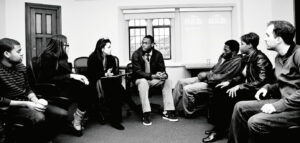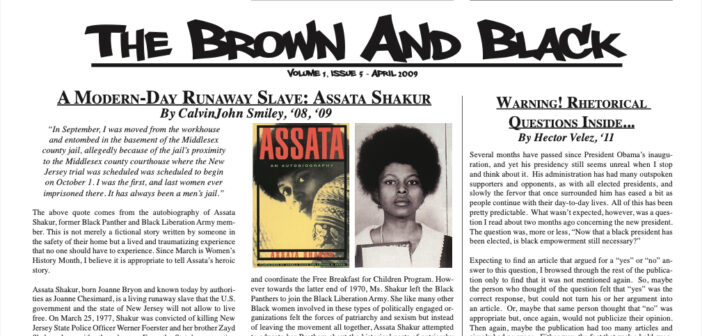Amidst the backdrop of racial incidents, a beacon of activism and advocacy emerged: Lehigh’s Brown and Black magazine.
The Brown and Black was first published in late 2008 and was created as a safe space for Black students at Lehigh.
Calvin John Smiley, ‘08, G‘09; Sonya James, ‘08, and Karl Brisseaux, ‘11, were among the students who created and edited the magazine.
This publication served as a platform to address racial injustices and foster discussions about race and gender within the Lehigh community.
The origins of The Brown and Black trace back to “The Movement,” a student group raising awareness about diversity at Lehigh.

The editors of The Brown & Black gather to discuss an upcoming issue. The last issue of The Brown & Black was published in 2011. (Courtesy of Lehigh University Special Collections)
During his time at Lehigh, Smiley said he could recount many racial incidents that went uninvestigated. He knew there had to be a space where Black students could address issues like this openly.
One incident involved a skinned deer head that was found at the Umoja House in 2004, propelling the magazine’s formation. This residence hall was created as “A Legacy of Black Student Activism for Racial Equality and Acceptance,” according to the Umoja House website.
This was not an isolated incident. Brisseaux also recounts racial slurs being hurled at Black women on Lehigh’s campus.
Both of these incidents went uninvestigated and unreported.
Reflecting on the climate of Lehigh at that time, Smiley said there was disparity in reporting between on-campus and off-campus incidents by The Brown and White.
“There was always this kind of erasure of violence or crime that happened on campus,” Smiley said. “We’re getting harassed.”
He said the lack of reporting on these incidents underscored the need for platforms like The Brown and Black to amplify marginalized voices both on and off campus.
During the spring of 2008, an interest meeting was held to bring attention to the idea of the magazine. Later that year, the first edition was published.
“The newspaper ran by committee, not by beat,” Brisseaux said. “The purpose was to make it more egalitarian than most newspapers ran.”
Ayana Wilcher, a former assistant director for diversity and career development, advised the magazine alongside Dr. Yaba Blay, a former professor and director of the joint multicultural program.
Blay also created the magazine’s title.
Shortly after the first edition, another quickly followed after the historic election of Barack Obama, highlighting a pivotal moment in American history.
“We didn’t get paid for any of this,” Smiley said as he reflected on their collective passion.
Still, even with the immense support this magazine had, there was pushback from other Lehigh students.
Brisseaux said when he wrote an article about an incident of two fraternity men who dressed up as the Williams sisters in blackface, some people scrutinized him for it.
During his senior year, Brisseaux said that he was a columnist for The Brown and White and his description mentioned he was the editor of The Brown and Black.
When his columns were published, he said many people made demeaning comments online, asking if it was a joke.
“For me, it was kind of disappointing sometimes but it was also brushing your shoulders off of it,” Brisseaux said.
After Smiley, James and Brisseaux graduated, the momentum behind the magazine gradually waned, fizzling out at the beginning of 2011.
While challenges and pushback may have marked its journey, The Brown and Black stood as a testament to the resilience and determination of its founders and contributors in the pursuit of racial and justice equity.
At the end of it all, James said there’s importance of having a village that was dedicated to the craft.
She said she knew how hard they all had to work for this magazine to come to fruition and advised that projects like these should always be done with a group of people.
“Taking on anything like this solo and hoping that people will contribute will never work out,” James said. “Have a committee.”
As Lehigh continues its journey towards a more inclusive campus environment, the spirit of The Brown and Black serves as a time capsule, inspiring future students to confront systemic injustice and strive for a more just and equitable campus.






Comment policy
Comments posted to The Brown and White website are reviewed by a moderator before being approved. Incendiary speech or harassing language, including comments targeted at individuals, may be deemed unacceptable and not published. Spam and other soliciting will also be declined.
The Brown and White also reserves the right to not publish entirely anonymous comments.